ORIF through modified Stoppa approach
1. General considerations
Sequence of the treatment
The Stoppa approach allows direct control of the anterior column around the acetabulum and it is often possible to control the reduction entirely at the level of the pelvic brim. This may enable the lateral window to become unnecessary and the approach limited to the Stoppa window only.
The sequence of reduction of the associated both column fractures traditionally begins with reduction of the iliac wing to the intact ilium.
However, small inaccuracies at the level of the iliac crest can lead to significant malreduction at the joint line and reduction of the pelvic brim first, followed by reduction and stabilization of the high and mid portions of the anterior column (1) is more successful. The posterior column (2) is then reduced to the anterior column. If there is low anterior column involvement (3), this is subsequently reduced.
If there is an associated posterior wall component, it is most commonly reduced after the posterior column reduction. Occasionally, in the case of very large posterior wall fragments, one may need to reduce the posterior wall prior to the posterior column.
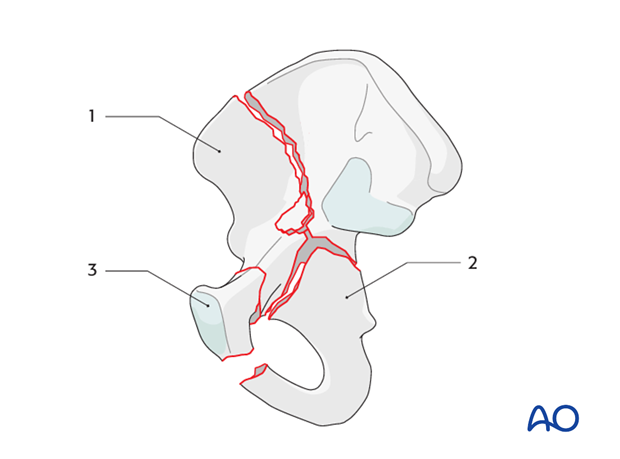
Planning/templating
Preoperative templating is essential for understanding the complexity of an acetabular fracture.
When using implants on the innominate bone, it is important to know the best starting points for obtaining optimal screw anchorage (see General stabilization principles and screw directions).
Patient positioning
This procedure is normally performed with the patient in a supine position.
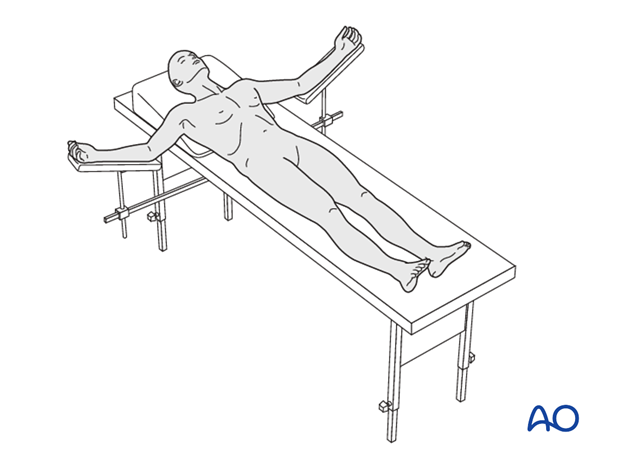
2. Principles of reduction
Introduction
Some fractures can be treated with use of the Stoppa window only. The lateral window from the ilioinguinal approach will supplement this.
The Stoppa approach allows better control of the periacetabular column than the ilioinguinal approach, such that instead of beginning the reduction at the crest and then using the pelvic brim plate to neutralize the reduction, the pelvic brim plate is used to drive the reduction as well as stabilize it.
Indirect visualization
Unusually for a significant joint, articular reduction of acetabular fractures is indirect. The articular surface of the hip joint is not seen directly. Reduction must be assessed by the appearance of the extraarticular fracture lines and intraoperative fluoroscopic assessment. Some fracture lines are palpated manually but not seen directly such as transverse fracture lines on the quadrilateral plate.
Marginal impaction in the posterior wall fracture can be seen directly prior to final closure of the cortical fragment.
Quality of reduction
Posttraumatic arthrosis is directly related to the quality of reduction - the better the reduction, the greater the chance of a good or excellent result.
3. Application of traction
It is critical to ensure hip flexion to allow enhanced exposure of the iliac fossa and true pelvis.
The associated both column fractures result from a force applied to the greater trochanter, with medialization of the femoral head. In order to allow manipulation of both the anterior and posterior column fragments, the femoral head must be distracted. This is typically accomplished with the application of lateral and/or longitudinal traction.
The application of traction also provides indirect reduction, particularly of the anterior column.
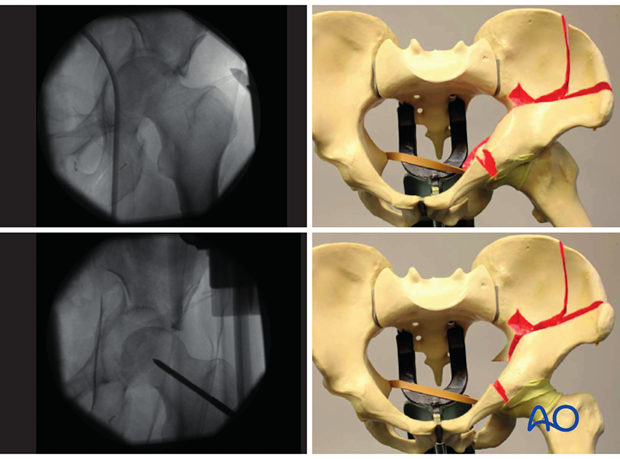
Traction can be applied in several ways with:
- The use of a fracture table that allows longitudinal and lateral traction
- The intermittent help of an assistant (may be unreliable in long procedures)
Apply longitudinal traction to the lower limb, and lateral traction through the greater trochanter.
Both these forces should be tuned until the best effect is obtained.
In some surgeon’s experience, the use of a traction table post or other traction frame is helpful during this operation.
Note
Excessive traction may limit fracture fragment mobility and interfere with reduction.

Teaching video
AO teaching video: Use of the distractor on the pelvis
4. Cleaning of the fracture site
Fracture sites are prepared by preliminarily increasing the displacement and then removing early callus and granulation tissue.
Joint distraction is extremely useful to facilitate this debridement.
5. Anterior column: reduction
Reduction of periacetabular fracture
The anterior column is reduced to the posterior ilium.
Restore the iliac fossa concavity by correcting external rotation and medial displacement of the deeper part of the anterior column fragment.
If required a small incision can be made in order to rotate the iliac wing internally using a ball spike pusher applied to the proximal posterior portion, near the pelvic brim, of the anterior column and a Farabeuf clamp positioned on the ASIS.
If indicated, use a Schanz screw that is driven into the AIIS combined with lateral traction on the femur to obtain the complete reduction.
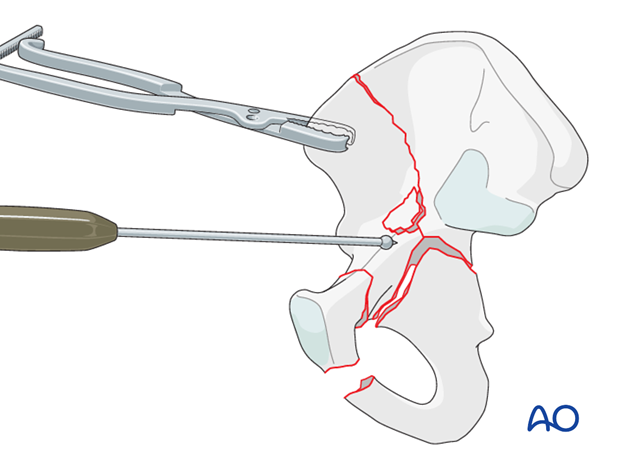
Use of a large symmetric reduction forceps (“King Tong”)
Additionally, or as an alternative, apply a large symmetric “King Tong” clamp around the anterior column and the fixed portion of the iliac wing to obtain correct rotation of the iliac wing and to restore the iliac fossa concavity.
Note
Excessive internal rotation will open the fracture on the opposite side.
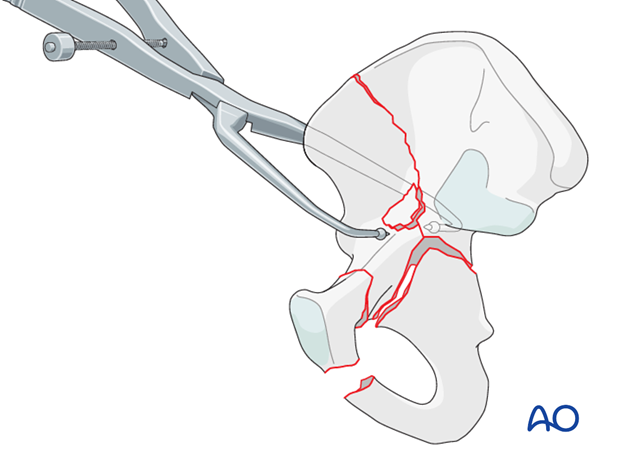
Plate as reduction aid
A powerful aid to reduction is a plate attached to the stable, posterior part of the ilium.
This plate is undercontoured to provide a push to the anterior column along the pelvic brim.
Place the distal part of the plate over the free anterior column fragment. Fix the plate with two cortical screws into the stable portion of the iliac wing. As its screws are tightened, the plate presses the anterior fragment into alignment with the intact ilium.
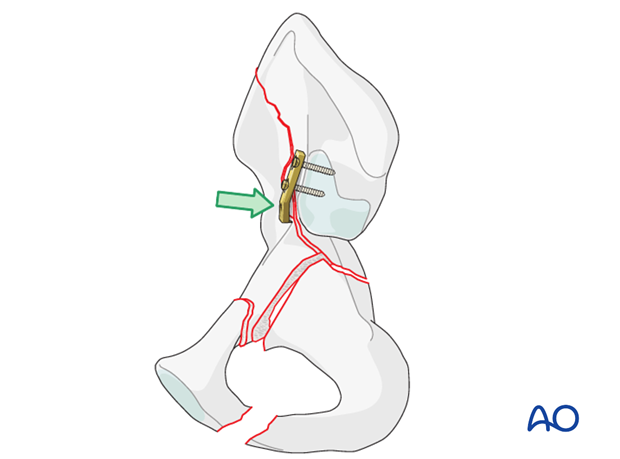
The reduction plate can be assisted with lateral femoral traction and the use of a Farabeuf clamp in the ASIS to obtain correct reduction.
Final fixation with a long reconstruction plate along the pelvic brim may require removal of the reduction plate.
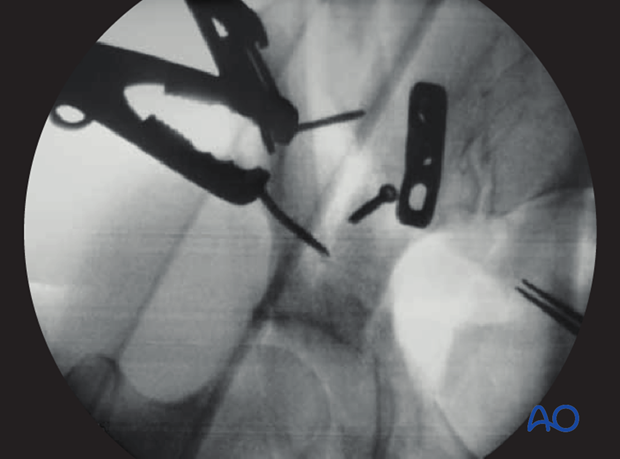
Reduction of the iliac wing
Once the periacetabular fracture is controlled reduction of the iliac wing to the intact ilium (portion of the ilium that remains normally associated with the sacrum) can begin if required.
High fractures will be adequately controlled by the fixation at the pelvic brim. It may be necessary to supplement this with the addition of a lateral window.
With an approach through a small lateral window, direct reduction and screw or plate fixation can be completed.
Start reduction from the proximal aspect of the iliac wing. Reduce accessory fragments of the iliac wing, if present.
It is important to restore the normal curvature of the iliac wing, and not to straighten it excessively.
Pointed reduction forceps applied to the iliac crest can serve as handles for reduction, and also for temporary fixation.
Alternatively, apply a Farabeuf clamp over screws placed into the crest on each side of a fracture line.
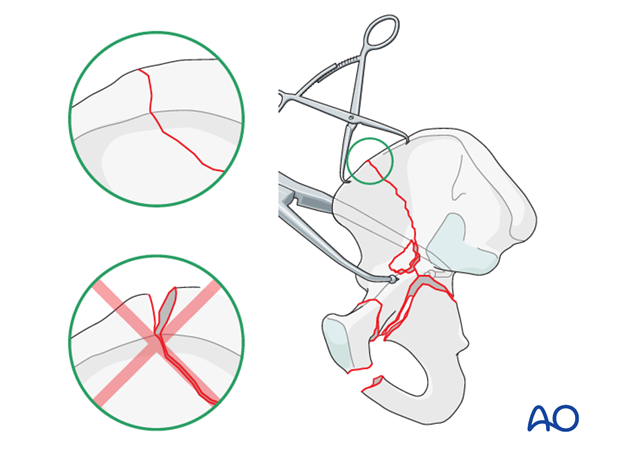
Fixation of the iliac wing
Iliac wing fractures can be fixed with lag screws (3.5 mm) near the crest.
Alternatively, one can use pelvic reconstruction plates applied to the inner surface of the iliac crest.
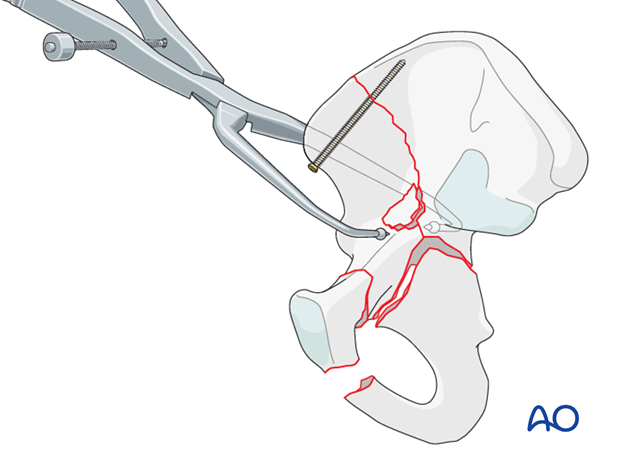
Pelvic brim fragment
Very commonly, there is a large separate fragment of bone just above the point that the anterior column fracture crosses the pelvic brim. This fragment must be reduced anatomically to allow a read of the anterior column reduction.
Manipulation with a dental pick and pressure with a ball spike pusher are helpful.
Once successfully reduced, provisional fixation with a K-wire may be useful. If the fragment is large enough, a 2.4 mm or a 3.5 mm screw can secure this fragment.
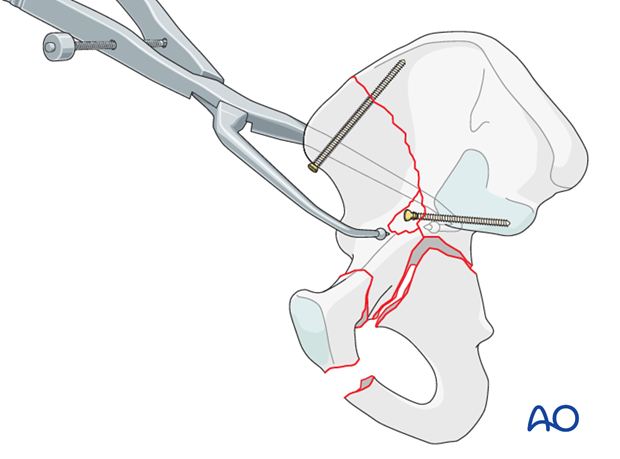
6. Anterior column: fixation
Components of fixation
Depending on the fracture configuration, a combination of the following fixation methods may be used:
- Small fragment lag screws stabilizing the anterior column to the reconstructed ilium
- A contoured pelvic brim buttress plate. This plate can be contoured to extend across the low anterior column to the pubis, as required by the specific fracture. Of note, fixation of the posterior column commonly occurs through the pelvic brim buttress plate as illustrated.
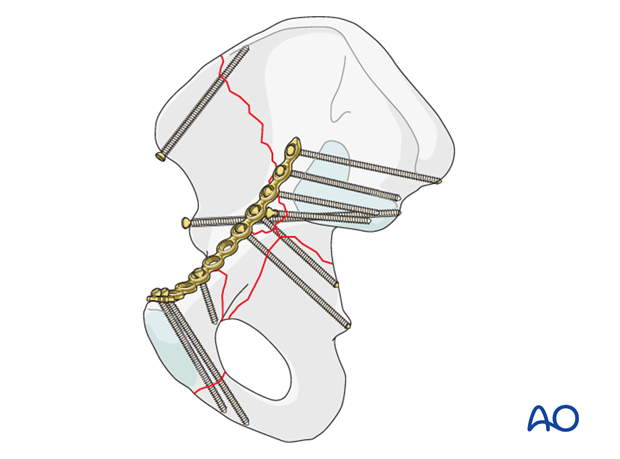
Iliac screws
Stabilize the anatomically reduced anterior column to the reconstructed ilium with one or more screws between the inner and outer cortex.
Small fragment screws placed along the iliac crest stabilize the proximal fracture line. Alternatively, one can use pelvic reconstruction plates applied to the inner surface of the iliac crest.
Iliac corridor screws can be applied beginning lateral to the anterior inferior iliac spine (AIIS) and directed into the posterior innominate bone, just lateral to the sacroiliac joint. This corridor is commonly large enough to accommodate two 3.5 screws or a 4.5 screw. Care should be taken to avoid perforating the inner or outer cortex of the ilium prematurely. C-arm imaging can be used to ensure that these screws stay between the surfaces to the posterior border of the bone.
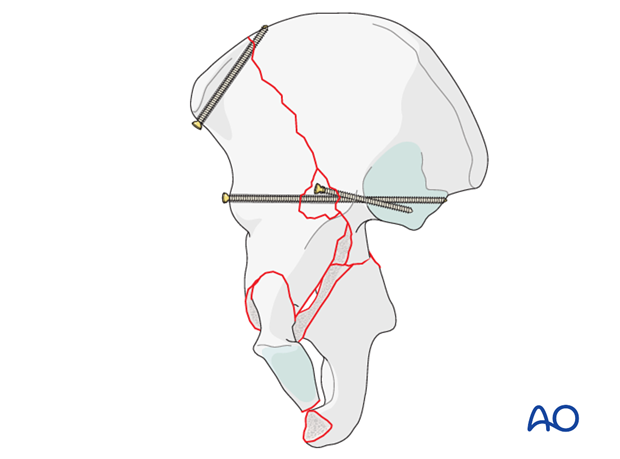
Contouring and applying a pelvic brim plate
Most commonly a pelvic brim plate will be used for the final construct. It will be contoured and applied to the anterior column at this point, though the fixation of the posterior column is performed after subsequent reduction.
The plate must be long enough to provide adequate fixation of both posterior and anterior injuries. This typically requires extension to the pubic body.
The use of a malleable template aids plate contouring.
Because the primary purpose of this plate is to buttress the anterior column, posterior contouring is most critical. For this reason, plate fixation normally starts posteriorly and proceeds anteriorly. Final adjustment of the plate profile can be achieved in situ, due to plate malleability.
Tools for in situ plate contouring include the ball spike for pushing, ...

... and large and small fragment screwdrivers for torsional adjustment.
Apply the plate along the pelvic brim spanning from the innominate bone adjacent to the SI joint to the pubis.

Plate fixation of the anterior column
The cranial most screws are placed parallel to the SI joint, anchoring the plate to the sciatic buttress. This provides assistance with the reduction (as previously described) as well as definitive buttress stabilization of the anterior column.
Screws can be placed through the plate into the reduced anterior column fragment, depending on the fracture morphology.
At this point, it is critical to ensure that no screws cross into the posterior column fracture or fragment. This would block the reduction of the posterior column fragments.
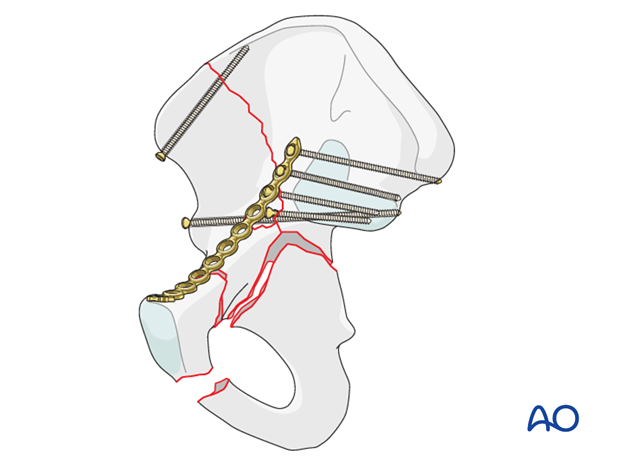
7. Posterior column: reduction
Fracture reduction
Reduction of the posterior column can be achieved utilizing multiple techniques.
Reduction is normally achieved by ligamentotaxis with distal and lateral traction through the femur. This can be augmented by placement of a small bone hook in the lesser sciatic notch. The hook can be used to laterally and anteriorly reduce the posterior column. Further techniques are listed below.
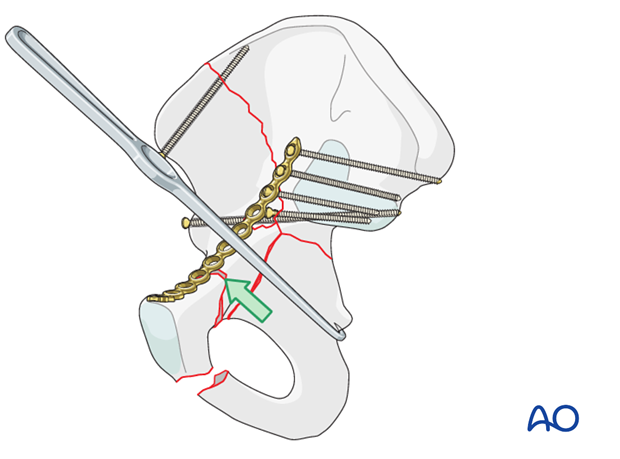
Offset quadrangular clamp
The most common reduction maneuver of the posterior column element is the use of the quadrangular clamp.
This clamp is applied with the short arm over the pelvic brim, and the second deep arm applied to the displaced posterior column along the quadrilateral surface.
Care must be taken to avoid excessive pressure on the vessels by the clamp or force of retraction.
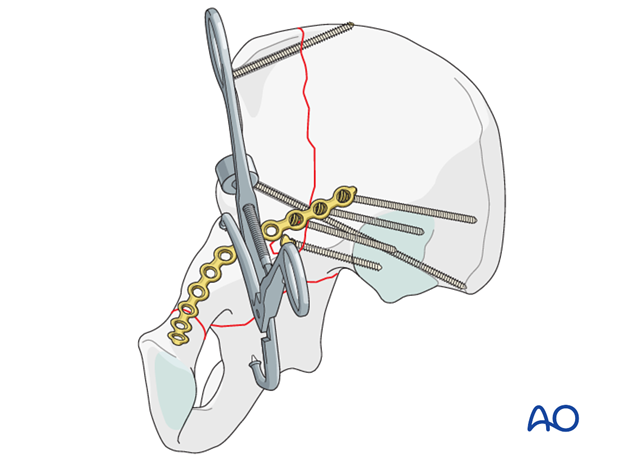
Use of pointed reduction forceps
The most direct technique uses pointed reduction forceps (or Weber clamp) which spans from the pelvic brim to the quadrilateral surface portion of the posterior column.

8. Posterior column: fixation
Anterior to posterior screw fixation
Posterior column fixation relies primarily on screws placed from the anterior column directed posteriorly.
When possible, it is desirable to place the posterior column fixation through the pelvic brim plate. The most posterior screw (ca 80 mm) is directed toward the ischial spine. It is usually possible to place a second screw (ca 100 mm) in the next anterior plate hole, directed toward the ischial tuberosity.
It may be necessary to place a screw outside of the plate instead. This screw typically starts just lateral to the pelvic brim plate at the level of the angle of the sciatic notch.
Regardless of configuration, it is important that at least two screws be used for the posterior column fixation. A single screw does not provide sufficient torsional stability.
If a reduction of the low anterior column is not required the construct is completed with the most anterior screws in the body.
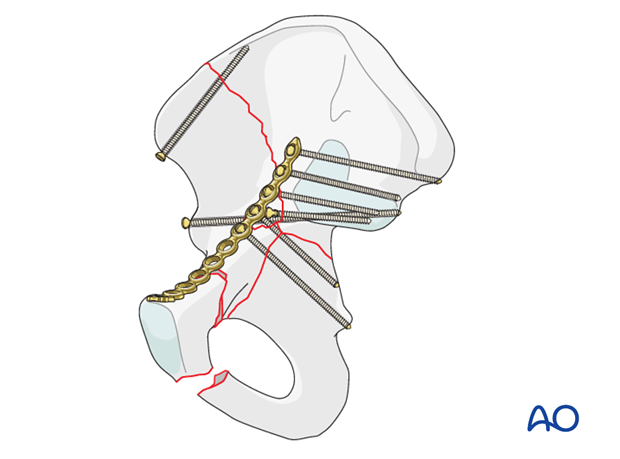
Fluoroscopic navigation of the posterior column screw placement
The iliac oblique view can be used to position the anterior to posterior screws. With the C-arm rolled away from the surgeon 45°, the posterior column is well visualized and the access unobstructed.
The drill can be advanced down the posterior column under fluoroscopic guidance, ensuring an extraarticular position as shown in the image. The screw can then be placed in the same tract.
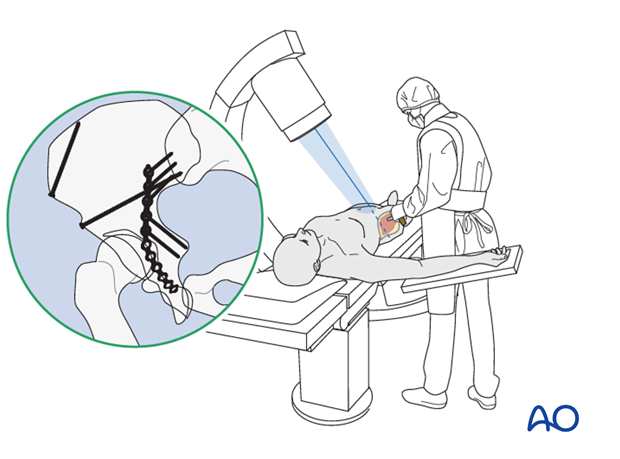
The obturator oblique view can be used to confirm appropriate placement. The projection of the screw should aim at the ischium. The most common mistake is to drive the screw in the direction of the posterior wall.
Screws that penetrate the posterior column cortex may injure the sciatic nerve.
Because this view is obtained with the C-arm rolled in the direction of the surgeon, access to the acetabulum is obstructed. This view is therefore used as confirmation and difficult to use for real time navigation.
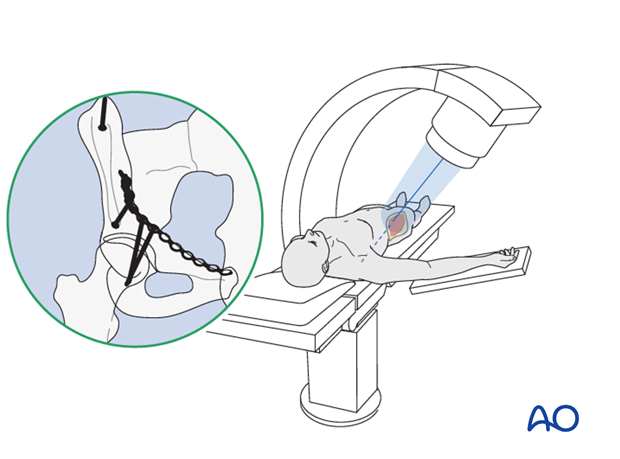
9. Distal anterior column: reduction and fixation
Reduction
Once the posterior column is definitively reduced and fixed, reduction of the distal anterior column may be required.
Indications for anatomic reduction and fixation of the distal anterior column include cases in which this fracture is articular involving the distal anterior wall and segmental fractures of the anterior column.
This reduction is commonly accomplished utilizing pointed reduction forceps.
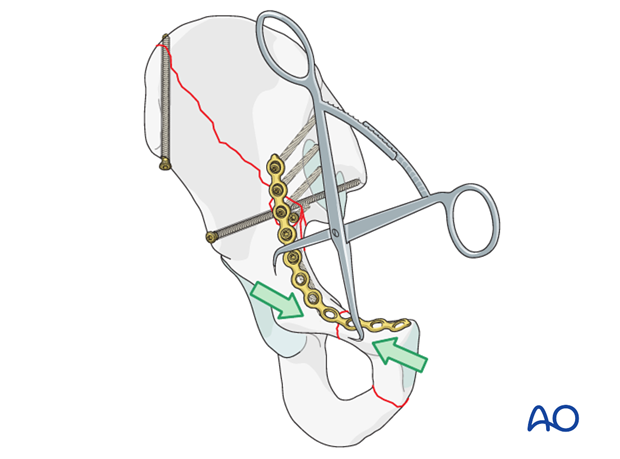
Fixation
Once the low anterior column and segmental portions of the anterior column have been successfully reduced, fixation through the previously contoured pelvic brim plate can be achieved.
Additional in situ contouring can be required as previously described.
Additional screws in the medial superior ramus and pubic body are inserted as needed.

10. Posterior wall: reduction and fixation
The association of a posterior wall fracture with a primary both column pattern is a relatively common variant.
Most commonly, the attempt at reduction and fixation of the posterior wall component occurs after reduction of the posterior column to the anterior column fragments.
The obturator oblique imaging is used for the reduction and fixation of this fragment.
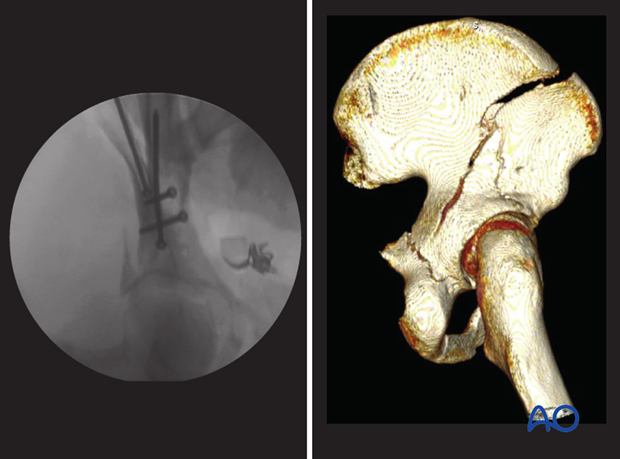
In some cases, the posterior wall fragments with supraacetabular extension can be reduced by limited external iliac exposure. A small window is developed along the anterior external ilium, by elevating the tensor fascia lata.
An elevator, ball spike pusher or clamp can be applied to reduce the posterior wall fracture. This is done under fluoroscopic guidance utilizing the obturator oblique projection as shown.
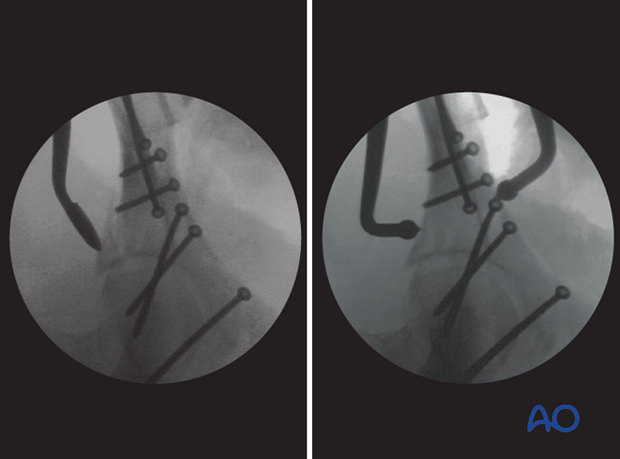
Once the fragment is reduced, place an interfragmentary screw from the internal iliac fossa into the posterior wall fragment.
If a satisfactory reduction of the posterior wall cannot be achieved with these techniques, a second posterior approach is required.
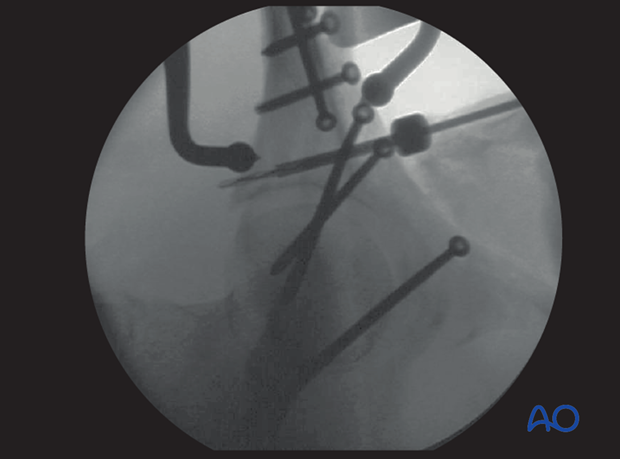
11. Final radiographic assessment
Once all fixation is in place, confirm the appropriate appearance of AP, obturator oblique and iliac oblique views and check the location of any screw that is placed near the hip joint.
The AP view should be inspected to assure that congruence has been obtained. The femoral head should have the same relationship to the radiological roof, the anterior rim and the posterior rim as on the contralateral side.
The pelvic brim plate should be secured to the intact ilium just lateral to the SI joint. The screws placed in the mid-section of the plate securing the posterior column reduction should be close to the ilioischial line.
If the low anterior column was affected, the obturator foramen profile and symphysis should be inspected to assess the quality of the distal reduction.

The obturator oblique should be inspected to ensure that there is no residual subluxation of the femoral head. The reduction of the anterior column should be assessed.
Both columns should be reduced to the intact ilium such that the ’spur sign’ is no longer visible.
The posterior column screws should be seen to be crossing the level of the posterior column fracture, and directed down the ischium and not in the direction of the posterior wall.
If a posterior wall fragment was involved, it should be seen as reduced and stabilized on this image.
The iliac oblique should be inspected to ensure that the posterior column reduction is anatomic. The screws directed down the posterior column should be inspected and verified as extraarticular.
The restoration of the iliac wing should be confirmed.
Postoperatively, obtain formal high-quality radiographs of AP and both oblique views.
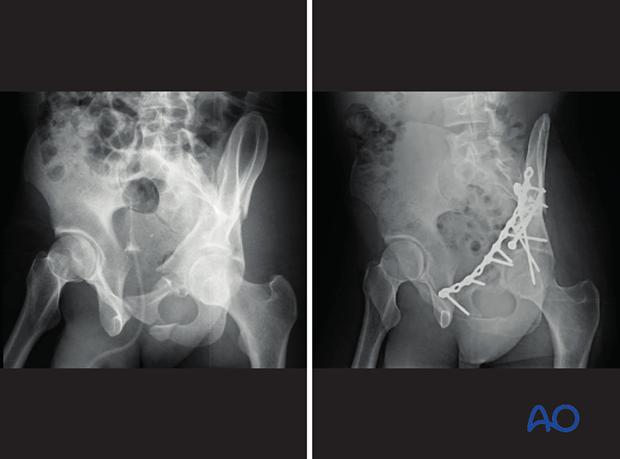
12. Postoperative care
During the first 24-48 hours, antibiotics are administered intravenously, according to hospital prophylaxis protocol. In order to avoid heterotopic ossification in high-risk patients, the use of indomethacin or single low dose radiation should be considered. Every patient needs DVT treatment. There is no universal protocol, but 6 weeks of anticoagulation is a common strategy.
Wound drains are rarely used. Local protocols should be followed if used, aiming to remove the drain as soon as possible and balancing output with infection risk.
Specialized therapy input is essential.
Follow up
X-rays are taken for immediate postoperative control, and at 8 weeks prior to full weight bearing.
Postoperative CT scans are used routinely in some units, and only obtained if there are concerns regarding the quality of reduction or intraarticular hardware in others.
With satisfactory healing, sutures are removed around 10-14 days after surgery.
Mobilization
Early mobilization should be stressed and patients encouraged to sit up within the first 24-48 hours following surgery.
Mobilization touch weight bearing for 8 weeks is advised.
Weight bearing
The patient should remain on crutches touch weight bearing (up to 20 kg) for 8 weeks. This is preferable to complete non-weight bearing because forces across the hip joint are higher when the leg is held off the floor. Weight bearing can be progressively increased to full weight after 8 weeks.
With osteoporotic bone or comminuted fractures, delay until 12 weeks may be considered.
Implant removal
Generally, implants are left in situ indefinitely. For acute infections with stable fixation, implants should usually be retained until the fracture is healed. Typically, by then a treated acute infection has become quiescent. Should it recur, hardware removal may help prevent further recurrences. Remember that a recurrent infection may involve the hip joint, which must be assessed in such patients with arthrocentesis. For patients with a history of wound infection who become candidates for total hip replacement, a two-stage reconstruction may be appropriate.
Sciatic nerve palsy
Posterior hip dislocation associated with posterior wall, posterior column, transverse, and T-shaped fractures can be associated with sciatic nerve palsy. At the time of surgical exploration, it is very rare to find a completely disrupted nerve and there are no treatment options beyond fracture reduction, hip stabilization and hemostasis. Neurologic recovery may take up to 2 years. Peroneal division involvement is more common than tibial. Sensory recovery precedes motor recovery and it is not unusual to see clinical improvement in the setting of grossly abnormal electrodiagnostic findings.













